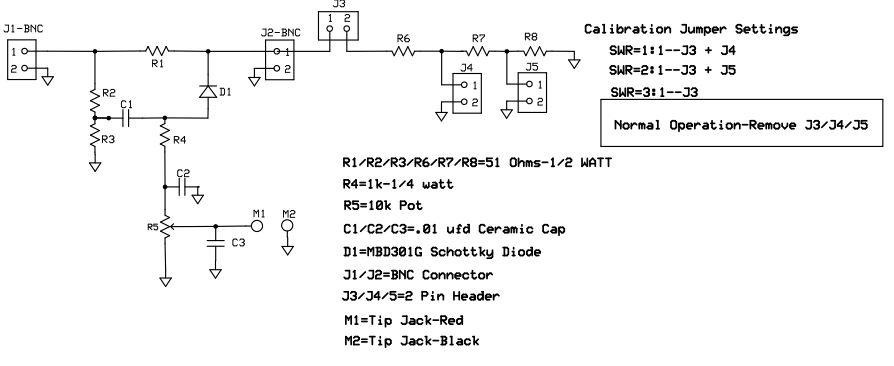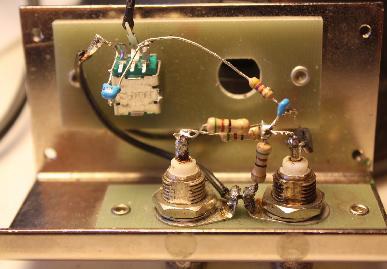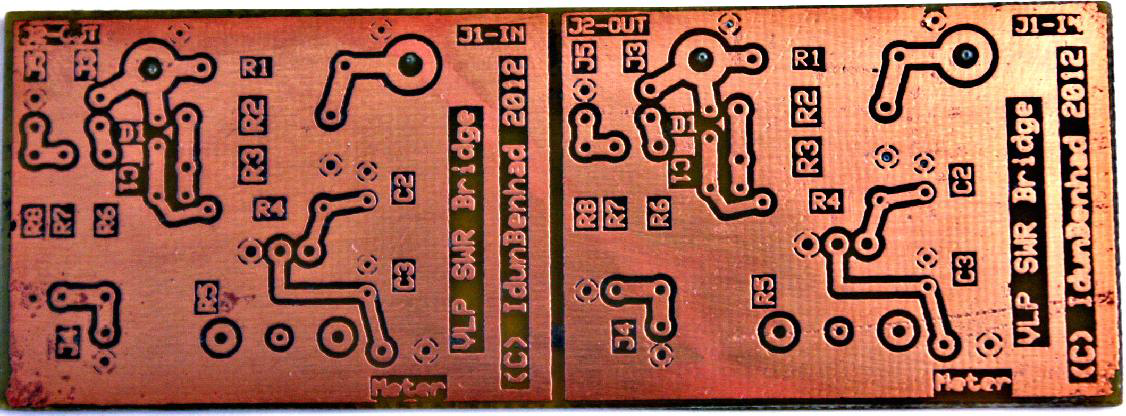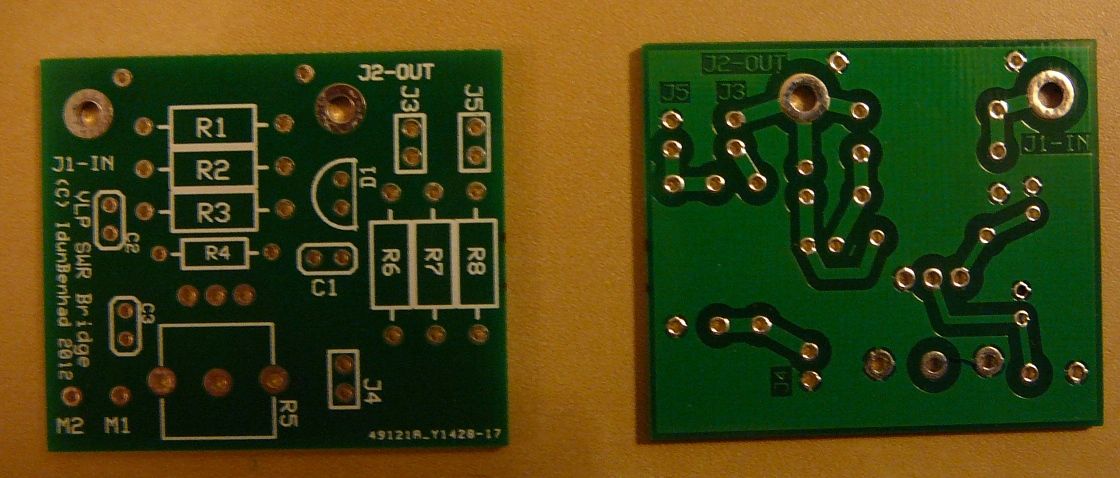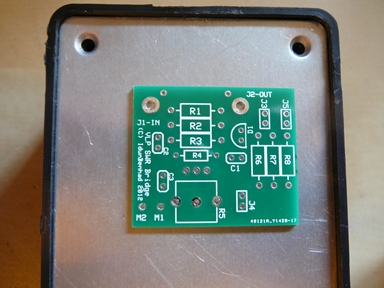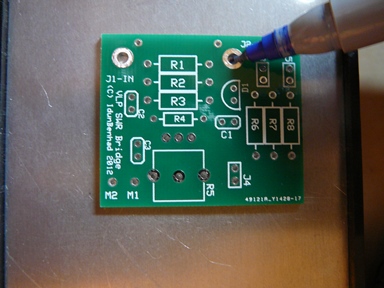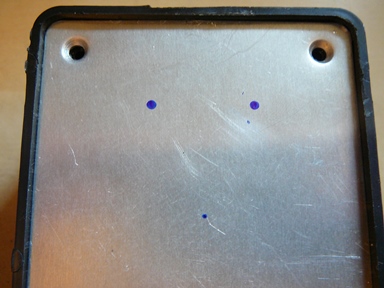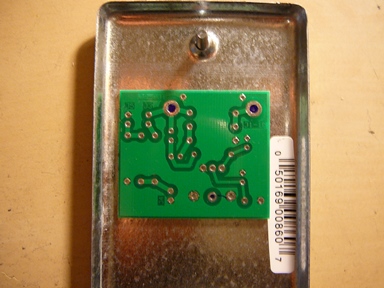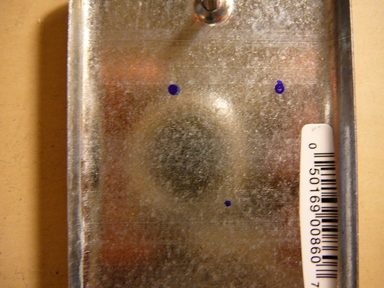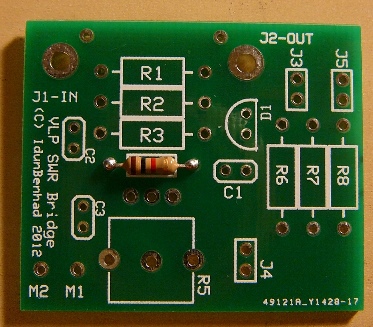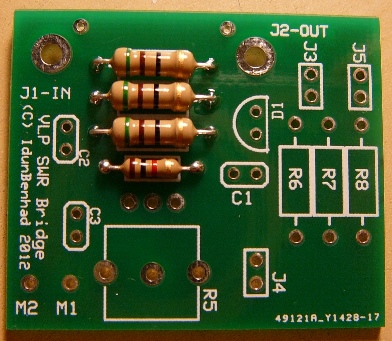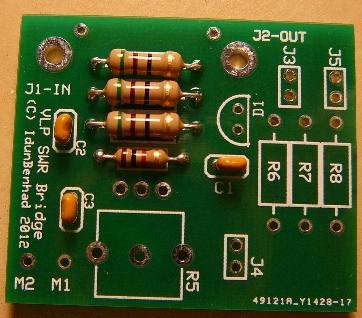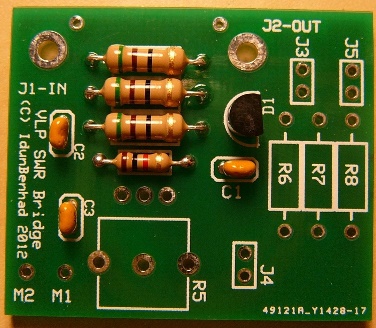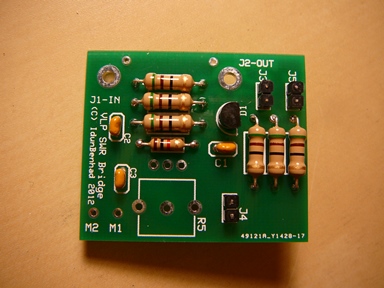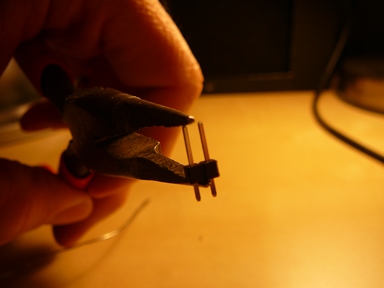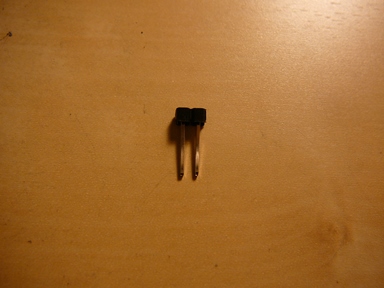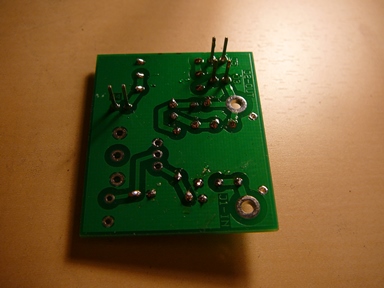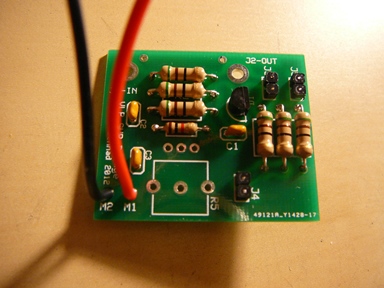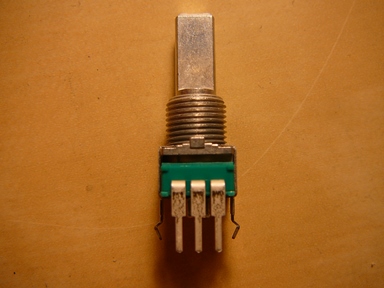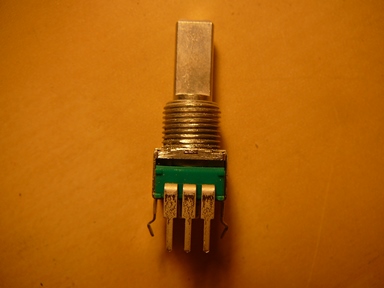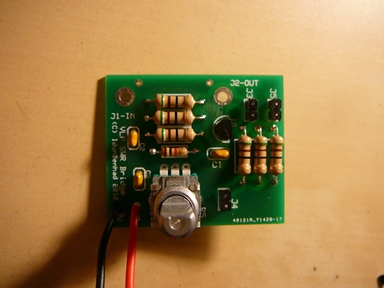VLP SWR Bridge
VLP SWR Bridge
The Very Low Power Standing Wave Ratio, or VLP SWR, Bridge is a tool designed by IdunBenhad for the DIY community. The bridge combined with a DVM or Ammeter will allow the user to "match" the antenna and other environmental variables with the with the transmitter.
What is SWR and how to measure it
SWR (standing wave ratio), is a measurement of how efficiently your antenna system will radiate the power available from your radio. In simple terms, your transmitter would like to radiate all of its power, but can only do so if the other components cooperate. Bad coax and mounts, or inefficient antennas and ground plane can cause system bottlenecks. The easiest way to understand the concept is to think of it in terms of water flow. That is, if you put a one inch faucet on a two inch pipe, your potential output will be restricted by the one inch outlet. So goes antenna systems. Setting your antennas SWR will reduce the restriction of radiated power. (1)
To measure SWR in a RF path or system, a SWR meter or bridge is placed in line and the votage readings are taken. Ideally, a SWR meter should be connected to the line as close as possible to the antenna: All practical transmission lines have a certain amount of loss, which causes the reflected wave to be attenuated as it travels back along the line. Thus, the SWR is highest closest to the load, and only improves as the distance from the load increases. (2)
Briefly, there are two types of SWR bridges. The first type is the design that uses a facsimile of a coax line as the pickup for processing and measuring the forward and reflected power of an antenna. This type requires a more powerful transmitter than the FM01/FM02 or similar types and are therefore not useful for our purposes.
The second is the resistive type SWR bridge/meter. This design is simple and easy to build. It uses low cost resistors and other components to accomplish what is needed to measure the antenna. It is accurate and easy to construct.
Most commercially available SWR meters are designed for higher power transmission systems. IdunBenhad discussed the non-availability of an SWR meter that would respond to “very low power” and said that there were no meters currently available that were usable for the DIYCer. After weeks of research and experimentation, he found and tested a workable solution that is low in cost to build and easy to use.
This meter is named: VERY LOW POWER (VLP) SWR Meter. This meter is not an original design, but was “borrowed” from other experimenters and designers.(3) The resistive meter presents a constant load to the transmitter and the SWR will not be over 2:1 even if the antenna is not connected. This is a safety factor for our transmitters, as THEY SHOULD NEVER BE TURNED ON WITHOUT AN ANTENNA, SWR METER OR SUITABLE LOAD CONNECTED.
VLP SWR Design and Schematic
Above is the schematic of the VLP SWR bridge. There are several changes from the original design from Keyser(2). Notably, it has a built-in calibration system consisting of R6-R7-R8 & J3-J4-J5. The diode has been changed from a germanium (1N34a type) to a Schottky diode, which is more sensitive than the original diode and is reversed from the original diagram.
The first attempt at this meter was a breadboard to see if it worked as advertised. Fig. 1 & Fig. 2 show how this was implemented and the meter worked very well. This allowed me to experiment and make changes easily. If the constructor wishes, this meter could easily be built as in the pictures and a PC board not used.
As the experimentation and measurements progressed, I discovered that reversing the diode D1 had an unexplained effect on the readings. If the diode were used as shown in the schematic, meter readings were adequate, even though the readings were negative voltage/current. If the diode were reversed as in the original design, meter readings were not enough to make the instrument useful. I have not been able to explain this phenomenon.
The reversing of diode D1 causes the voltage/current output to be negative, but causes no problems if a DVM is used as it automatically accepts plus or minus voltages. If a microammeter is used, all that has to be done is reverse the positive and negative leads.
The resistors R1-R2-R3-R6-R7-R8 are ½ watt. This means the meter can handle ½ watt of power. As the FM01/02 is only about 30 milliwatts this meter is much more than adequate. It you are using a higher power transmitter, it will handle up to ½ watt or 500 milliwatts.
The main concern in building this meter was the availability of parts and cost. Because most DIYCers already have a DVM or analog VOM, a dedicated microammeter is not included, thus saving that cost. Most DVMs have a low voltage range of 200 Millivolts and this is ideal. Ease of construction and use was kept in mind and to that end a PC board was designed and etched. The “built-in calibrator” has been designed into the board. The calibrator is seldom used but I felt it was necessary to have a readily available source of calibration so the user would be aware of the readings and the actual SWR. The calibration circuitry consists of R6-R7-R8 & J3-J4-J5, a very low-cost addition.
The PC board used can be home-etched and went through several iterations before the layout was final. The PC board in below performs very good and makes a strong unit. Shown in Fig. 3 are 2 boards etched at the same time. I used ExpressPCB to layout the board. The 3.8” x 1.4” board was then cut apart, ending up with two 1.9” x 1.4” boards. The ExpressPCB pattern is in the Coppers section on the DIYC board.
A group buy was also run on this where a production PCB was made. The layout is similar, but the PCB slightly smaller to the original to reduce production costs.
BOM
The construction is slightly unconventional and the assembly instructions should be followed carefully. If you can solder a Renard SS board, and can use a drill then you can make this board without problem.
The Current BOM is below QTY Part Desc Mouser # 6 R1-R3/R6-R8 Resistor-51 ohms/½ watt Carbon Film 293-51-RC 1 R4 Resistor-1k ohms/1/4 watt Carbon Film 291-1k-RC 1 R5 Potentiometer-10k—vertical mount 688-RK09L114001T 3 C1-C3 Capacitor-.01 ufd/50v Ceramic 594-K103K15X7RF5TL2 (or alt 21RX410-RC) 1 D1 Schottky Diode 863-MBD301G 2 J1-J2 BNC Panel Connector 571-5-1634523-1 (or atl 523-112575) 1 M1 Tip Jack-Red 530-105-0802-1 1 M2 Tip Jack-Black 530-105-0803-1 1 Knob 6mm D-Shaft 450-4763 3 J3-J4-J5 2 pin header 538-22-03-2021 3 Shunt 2 pin shorting for J3-J4-J5 151-8000-E 1 Enclosure* 616-74923-510-28
- Mouser Part 616-74923-510-28, is what was originally used in the prototype, but there are many different sources. Radio Shack has Part # 270-1805, which is much larger than needed but cheaper than Mouser. Or a cheap alternative is Lowes #72440 plus 70972 (single gang box with metal blank cover), total with tax is under a dollar at this writing.
VLP SWR Bridge Construction
The construction is slightly unconventional and the assembly instructions should be followed carefully. If you can solder a Renard SS board, and can use a drill then you can make this board without problem.
1) Inspect board for any obvious manufacturing defects
2) Before Soldering any parts, prepare the front panel of your enclosure. You can use the template File:SWR3a-Front-Panel 1333828358.pdf or use the PCB to mark the enclosure lid or panel with a fine point sharpie or pencil for the drill positions for the BNC jacks and pot shaft. J1 and J2 are the BNC connectors. The via inside the R5 silk screen is the potentiometer marking location.
If marking the top of the panel make sure you have the top of the PCB (silk screen visible) while marking
Or If marking the back of the panel make sure you have the bottom of the PCB (silk screen NOT visible) while marking.
For these three holes you will need to drill with a 3/8" bit.
You will also need to mark and drill two holes for the tip jacks. Drill 1/4" for these.
3) Insert R4 (1K-1/4 watt resistor). Part is not polarized and can be installed in either direction. Solder into place and clip leads. Save these two leads for later use.
4) Insert R1-R2-R3 (51 ohms-1/2 watt resistor). Part is not polarized and can be installed in either direction.
Solder into place and clip leads. If you forgot to save the leads from step 2, save two of them now.
5) Insert C1-C2-C3 (.01 ufd capacitor). Part is not polarized and can be installed in either direction.
Solder into place and clip leads.
6) Insert D1 (Schottky Diode). Part IS polarized, observe direction and install with flat on diode matching the silk screen.
Solder and clip leads.
7) Insert R6-R7-R8 (51 ohms-1/2 watt resistor). Part is not polarized and can be installed in either direction.
Solder into place and clip leads. If you forgot to save the leads from step 1 or 2, save two of them now.
Also picture shows header pins already installed, i forgot to take a pic after installing just the resistors, sorry!
8) Prepare and Install J3-J4-J5 (2 pin headers). The pins of the header are moved in the plastic mount until they are flush. See first two pics below picture below.
Insert part from the front of the board so the pins are sticking out of the back as shown and solder. DO NOT Clip the pins after soldering.
9) Install M1 & M2 wire. Cut a RED and BLACK wire each 2 inches long, strip the ends and tin. Insert the BLACK (M2) wire into the
Ground hole and the RED (M1) wire into the Meter hole coming from the pot. Solder both into place.
10) Prepare & Install R5 (potentiometer). There is a small tab on the potentiometer that is for alignment purposes, you can notch your panel for this or as it is really not needed file it off.
Place R5 on the board BUT DO NOT SOLDER AT THIS TIME. If your panel holes don't quite line up you may put stress on the solder joints and break them if you solder now.
Refernces
(1) http://www.firestik.com/Tech_Docs/Setting_SWR.htm
(2) ARRL Antenna Book, 2007, p. 28-7
(3) Resistive SWR Bridge by Ian Keyser, http://www.gqrp.org/resistive_swr_bridge.pdf
